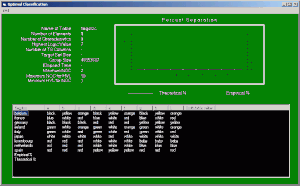Optimal classification refers to any method of classification[1], which inclusively minimizes the number of queries necessary to identify a particular element within a bounded class[2].
Table of Contents[]
- Truth Table Size-Related Equations
- Separatory Equations
- Element-Related equations
- Characteristic-related equations
- Theoretical separation
- Empirical separation
- Computational Example
- Application Example
Notes and References[]
- ↑ Although classification elements and attributes and decision actions and conditions may employ tables and trees there are important differences in how each is defined. A classification table or tree is defined by having an element with at least one attribute with at least one value and may have more than one element, attribute or attribute value but may not have more than one element per rule. On the other hand, a decision table or tree may have more than one condition per rule, more than one state per condition and more than one action per rule.
- ↑ A bounded class is a collection of elements defined by the same finite group of attributes. A [tuple] may refer to a bonded class which is ordered.
Specific applications[]
- Artificial Neural Networks
- Compute minimum number of hidden nodes
- Minimize training time
- Dynamic classification of publications
- Soil taxonomy
- Decision Table Optimization
See also[]
External links[]
- CLASSIFICATION OF LIVING THINGS
- LIBRARY OF CONGRESS CLASSIFICATION OUTLINE
- North American Industry Classification System (NAICS)
- 2000 Mathematics Subject Classification
- Standard Industrial Classification (SIC) System Search
- U.S. Patent Classification (USPC) System
- The Classification Society of North America (CSNA)
